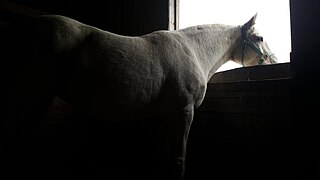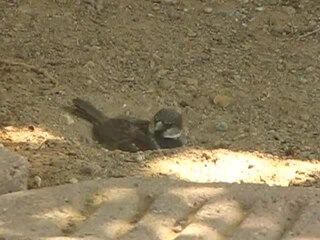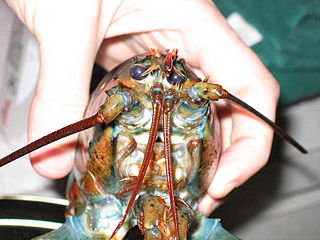
Nikolaas "Niko" Tinbergen was a Dutch biologist and ornithologist who shared the 1973 Nobel Prize in Physiology or Medicine with Karl von Frisch and Konrad Lorenz for their discoveries concerning the organization and elicitation of individual and social behavior patterns in animals. He is regarded as one of the founders of modern ethology, the study of animal behavior.

Instinct is the inherent inclination of a living organism towards a particular complex behaviour, containing innate (inborn) elements. The simplest example of an instinctive behaviour is a fixed action pattern (FAP), in which a very short to medium length sequence of actions, without variation, are carried out in response to a corresponding clearly defined stimulus.

Dog training is a kind of animal training, the application of behavior analysis which uses the environmental events of antecedents and consequences to modify the dog behavior, either for it to assist in specific activities or undertake particular tasks, or for it to participate effectively in contemporary domestic life. While training dogs for specific roles dates back to Roman times at least, the training of dogs to be compatible household pets developed with suburbanization in the 1950s.
"Fixed action pattern" is an ethological term describing an instinctive behavioral sequence that is highly stereotyped and species-characteristic. Fixed action patterns are said to be produced by the innate releasing mechanism, a "hard-wired" neural network, in response to a sign/key stimulus or releaser. Once released, a fixed action pattern runs to completion.

Weaving is a behaviour in horses that is classified as a stable vice, in which the horse repetitively sways on its forelegs, shifting its weight back and forth by moving the head and neck side to side. It may also include swaying of the rest of the body and picking up the front legs. Some horses exhibit non-stereotypical weaving, and instead engage in variations on this behavior.

Instinctive drift, alternately known as instinctual drift, is the tendency of an animal to revert to unconscious and automatic behaviour that interferes with learned behaviour from operant conditioning. Instinctive drift was coined by Keller and Marian Breland, former students of B.F. Skinner at the University of Minnesota, describing the phenomenon as "a clear and utter failure of conditioning theory." B.F. Skinner was an American psychologist and father of operant conditioning, which is learning strategy that teaches the performance of an action either through reinforcement or punishment. It is through the association of the behaviour and the reward or consequence that follows that depicts whether an animal will maintain a behaviour, or if it will become extinct. Instinctive drift is a phenomenon where such conditioning erodes and an animal reverts to its natural behaviour.

Behavioral enrichment is an animal husbandry principle that seeks to enhance the quality of captive animal care by identifying and providing the environmental stimuli necessary for optimal psychological and physiological well-being. Enrichment can either be active or passive, depending on whether it requires direct contact between the animal and the enrichment. A variety of enrichment techniques are used to create desired outcomes similar to an animal's individual and species' history. Each of the techniques used is intended to stimulate the animal's senses similarly to how they would be activated in the wild. Provided enrichment may be seen in the form of auditory, olfactory, habitat factors, food, research projects, training, and objects.

Displacement activities occur when an animal experiences high motivation for two or more conflicting behaviours: the resulting displacement activity is usually unrelated to the competing motivations. Birds, for example, may peck at grass when uncertain whether to attack or flee from an opponent; similarly, a human may scratch their head when they do not know which of two options to choose. Displacement activities may also occur when animals are prevented from performing a single behaviour for which they are highly motivated. Displacement activities often involve actions which bring comfort to the animal such as scratching, preening, drinking or feeding.

Dust bathing is an animal behavior characterized by rolling or moving around in dust, dry earth or sand, with the likely purpose of removing parasites from fur, feathers or skin. Dust bathing is a maintenance behavior performed by a wide range of mammalian and avian species. For some animals, dust baths are necessary to maintain healthy feathers, skin, or fur, similar to bathing in water or wallowing in mud. In some mammals, dust bathing may be a way of transmitting chemical signals to the ground which marks an individual's territory.

Fish fulfill several criteria proposed as indicating that non-human animals experience pain. These fulfilled criteria include a suitable nervous system and sensory receptors, opioid receptors and reduced responses to noxious stimuli when given analgesics and local anaesthetics, physiological changes to noxious stimuli, displaying protective motor reactions, exhibiting avoidance learning and making trade-offs between noxious stimulus avoidance and other motivational requirements.

Pain in crustaceans is a scientific debate which questions whether they experience pain or not. Pain is a complex mental state, with a distinct perceptual quality but also associated with suffering, which is an emotional state. Because of this complexity, the presence of pain in an animal, or another human for that matter, cannot be determined unambiguously using observational methods, but the conclusion that animals experience pain is often inferred on the basis of likely presence of phenomenal consciousness which is deduced from comparative brain physiology as well as physical and behavioural reactions.

Abnormal behavior of birds in captivity has been found to occur among both domesticated and wild birds. Abnormal behavior can be defined in several ways. Statistically, 'abnormal' is when the occurrence, frequency or intensity of a behaviour varies statistically significantly, either more or less, from the normal value. This means that theoretically, almost any behaviour could become 'abnormal' in an individual. Less formally, 'abnormal' includes any activity judged to be outside the normal behaviour pattern for captive birds of that particular class or age. For example, running rather than flying may be a normal behaviour and regularly observed in one species, however, in another species it might be normal but becomes 'abnormal' if it reaches a high frequency, or in another species it is rarely observed and any incidence is considered 'abnormal'. This article does not include 'one-off' behaviours performed by individual birds that might be considered abnormal for that individual, unless these are performed repeatedly by other individuals in the species and are recognised as part of the ethogram of that species.
Sham dustbathing is a behaviour performed by some birds when kept in cages with little or no access to litter, during which the birds perform all the elements of normal dustbathing, but in the complete absence of any substrate. This behaviour often has all the activities and temporal patterns of normal dustbathing, i.e. the bird initially scratches and bill-rakes at the ground, then erects its feathers and squats. Once lying down, the behaviour contains four main elements: vertical wing-shaking, head rubbing, bill-raking and scratching with one leg. Normal dustbathing is a maintenance behaviour whose performance results in dust collecting between the feathers. The dust is then subsequently shaken off which reduces the amount of feather lipids and so helps the plumage maintain good insulating capacity and may help control of ectoparasites.
Toe pecking, an abnormal behaviour of birds in captivity, occurs when one bird pecks the toes of another using its beak. This behaviour has been reported in hens and ostriches. Studies have shown that hens exposed to toe pecking have significantly enlarged adrenal glands, indicating increased physiological stress. Hens exposed to toe pecking will step off a raised platform more quickly than control hens, possibly suggesting a heightened fear of elevation. They have also been reported to show depressive behaviour when afflicted by toe-pecking. The act of toe pecking leads to open wounds which are viable for infection and disease to develop. In severe forms, toe pecking can be classified as a cannibalistic behaviour and has been reported as a cause of mortality.

A preference test is an experiment in which animals are allowed free access to multiple environments which differ in one or more ways. Various aspects of the animal's behaviour can be measured with respect to the alternative environments, such as latency and frequency of entry, duration of time spent, range of activities observed, or relative consumption of a goal object in the environment. These measures can be recorded either by the experimenter or by motion detecting software. Strength of preference can be inferred by the magnitude of the difference in the response, but see "Advantages and disadvantages" below. Statistical testing is used to determine whether observed differences in such measures support the conclusion that preference or aversion has occurred. Prior to testing, the animals are usually given the opportunity to explore the environments to habituate and reduce the effects of novelty.

Comfort behaviours in animals are activities that help maintain the pelage, feathers, integuement or musculoskeletal system and increase the physical comfort of the animal.
Wallace Craig (1876–1954) was an American experimental psychologist and behavior scientist. He provided a conceptual framework for the study of behavior organization and is regarded as one of the founders of ethology. Craig experimentally studied the behavioral expression of emotion, the way innate and learned behavioral tendencies are integrated, and how vocal as well as social behaviors are organized. He encouraged a view of behavior as an integrated process with evolutionary, motivational, experiential, social and ecological degrees of freedom. This integrative perspective helped shape modern behavioral science.

Christopher M. Sherwin was an English veterinary scientist and senior research fellow at the University of Bristol Veterinary School in Lower Langford, Somerset. He specialised in applied ethology, the study of the behaviour of animals in the context of their interactions with humans, and of how to balance the animals' needs with the demands placed on them by humans.
Aggression in cattle is usually a result of fear, learning, and hormonal state, however, many other factors can contribute to aggressive behaviors in cattle.















